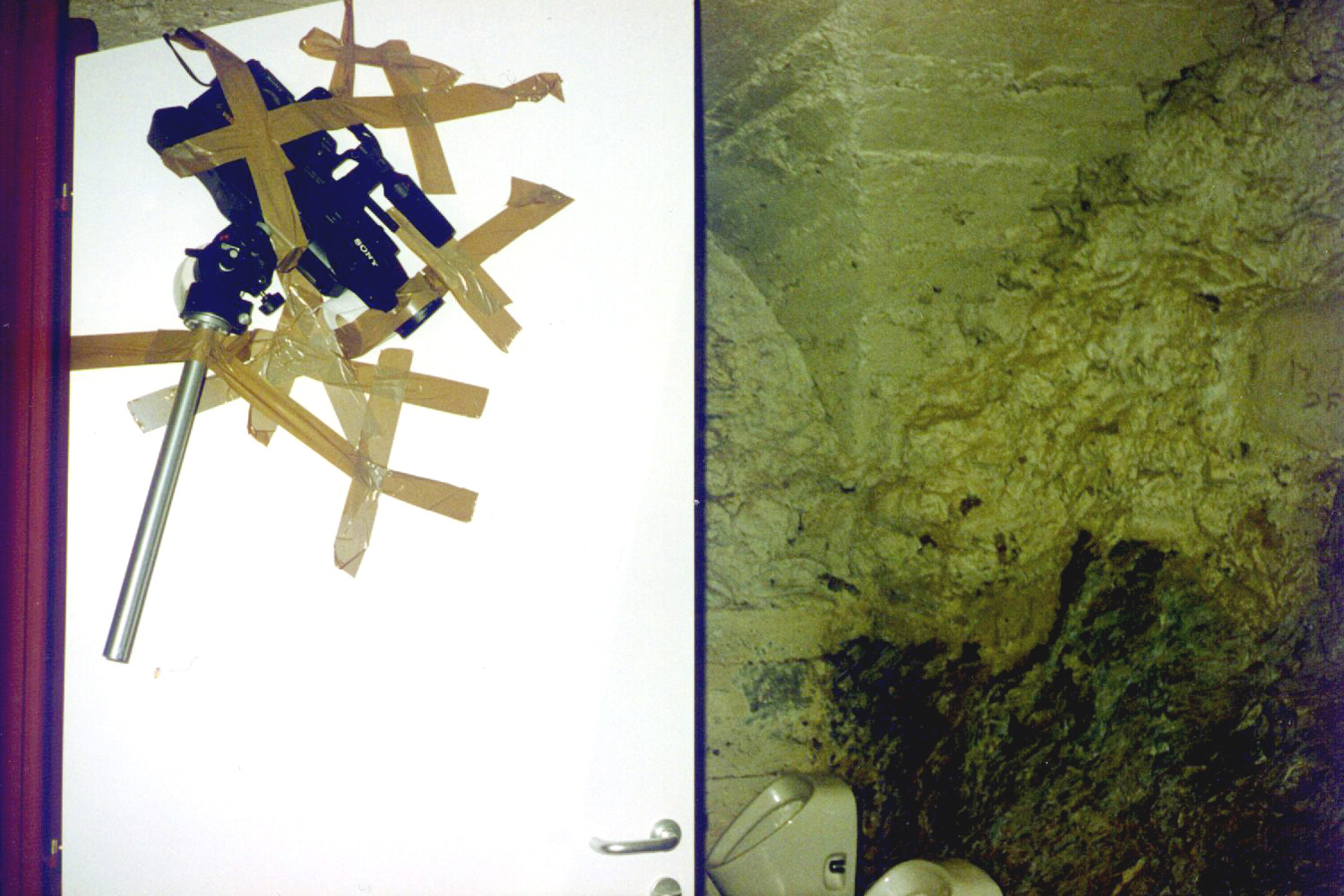Schloß Trautenfels
Video by Manfred Wolff-Plottegg © 1993 (already)
Videofilm:
Trautenfelsaus Sicht der Bauteile ...... Trautenfels as seen by its building components
>>>> link mp4
 |
 |
Stage direction:
Fix a camera on moving components of the building > shoot! > move the components.
The camera
was mounted on the following components:
sliding entrance door,
sliding window of cash desk, corridor door, toilet door, toilet seat,
toilet lid, flush button, toilet paper roll, door buckles, lift,
handrail, door-step-step-door
In this way it is recorded what the components see day in and day out
(even without eyes).
Direction: Manfred Wolff-Plottegg
Editing: Schedlbauer / Zoepnek
Camera guidance: various components
Duration: 6 minutes
© Manfred Wolff Plottegg 1993 (alread
|
The concept for the direction & camera views of this film departs radically from
the old issue "is it the object or the camera that is moving?", which is based
on the assumption of the difference between object and eye and on the preconception that
the eye is normally assigned to an human observer. Based on this general assumption,
camera control usually pretends that a person is moving through the building, mostly
coming from the outside, passing the entrance, walking up the staircase, into a room
inside, catching a view of a detail, a view from the window, etc..
This traditional position has been adjusted several times: since long in the "
frog" or "bird's eye perspective", and recently in computer animations: the
camera no longer replaces the human eye, any camera position can be simulated, where no
human eye could possibly be physically located, e.g. in the corner of a mouse hole; lights
can be set where no physical space is available. The space concept of open architecture
makes the notions of "points of view" and "perspective" obsolete.
Algorithmic planning makes anthropocentric objectives relative, and the dissolution of the
body theories corresponds to de-subjectivism.
The architectural concept for the revitalization of the castle at Trautenfels (1990-92)
leads in this direction. According to the principles of " algorithmic
architecture" (see Passagen Verlag 1996), the components no longer look like
well-known architectural elements; that means a door looks like (is) a stair, ditch
components make up WC walls, paving-stones are lamp shades, etc...
In the same way, the direction for the film and camera movement is algorithmic. The
mode of perception corresponding to the human eye is abandoned; the picture is not
controlled anymore by the brain / eye. In "Trautenfels as seen by its building
components", the procedure leads to a synectic excursion, looking for the moveable
building components, fastening the camera to them, moving the component during the action.
This film does not show what the human eye sees, but what the building components see;
e.g. the sliding doors, the toilet-cover, the flushing handle, the door knobs, the
elevator, the " Doorsteppedstepdoor" are watching their surrounding.
TRAUTENFELS AUS SICHT DER BAUTEILE
Das Regie- & Kamerakonzept für diesen Film verläßt die alte Überlegung
„bewegt sich das Objekt oder die Kamera“, wobei - so oder so - die Differenz
zwischen Objekt und Okular Vorraussetzung, das Okular dem Beobachter = Mensch als
Betrachter zugeordnet war. Daraus ergab sich stets eine Kameraführung, als ob eine Person
durch das Gebäude wandert - zumeist von außen kommend, dann durch das Eingangstor, die
Stiege hinauf, in ein Zimmer hinein, ein Blick auf ein Detail, ein Ausblick zum Fenster
hinaus, etc etc.
Diese traditionelle Position konnte mehrfach relativiert werden: in der
„Frosch-“ bzw. „Vogelperspektive“, und neuerdings in
Computeranimationen ersetzt die Kamera nicht mehr das menschliche Auge, es können
Kamerapositionen simuliert werden, wo physisch kein menschliches Auge sein könnte, zB. in
der Mauseloch-Ecke; Scheinwerfer können gesetzt werden, wo physisch kein Platz dafür
wäre. Im Raumkonzept der offenen Architektur sind Standpunkte, die Perspektive obsolet.
Algorithmische Planung relativiert anthropozentrische Zielsetzungen, der Auflösung der
Körpertheorien entspricht die Entsubjektivierung.
Schon das architektonische Konzept für den Umbau von Schloß Trautenfels (1990-92)
arbeitet in diese Richtung. Entsprechend den Überlegungen der „Architektur
Algorithmen“ (vgl. Passagen Verlag 1996) sehen die Bauteile nicht mehr so aus wie
bekannt; dh. eine Türe sieht aus wie (ist) eine Treppe, Künetten-Bauteile (Spundwände)
sind WC-Wände, Pflastersteine sind Lampenschirme etc. etc.
Folglich ist auch die Regieanweisung = Kamerafahrt algorithmisch. Der Ort / die
Sehweise des menschlichen Auges wird verlassen - das Bild wird nicht mehr vom Kopf / Auge
gesteuert. In „Trautenfels aus Sicht der Bauteile“ lautet die Prozedur zur
synektischen Exkursion: Suche im Gebäude bewegliche Bauteile, befestige das Okular daran,
bewegen den Bauteil während der Aufnahme.
Dieser Film zeigt nicht was das menschliche Auge sieht, sondern was die Bauteile sehen;
die Schiebetüren, der Klodeckel, der Spülknopf, die Türschnallen, der Lift, die
Türtreppentreppentüre betrachten ihre Umgebung.
Regie: Manfred Wolff-Plottegg
Schnitt: Schedlbauer / Zöpnek
Kameraführung: diverse Bauteile
Länge: 6 Minuten
© Manfred Wolff-Plottegg schon 1993
*** Trautenfels***

